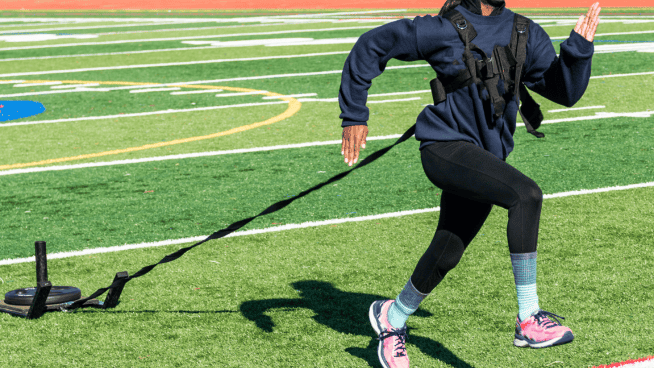How You Are Screwing Up Assisted Pull-Ups?
Assisted Pull-Ups are often used for clients or athletes who lack the strength to perform bodyweight Pull-Ups in their programming. However, the common method of attaching the band from the bar can mess up your Pull-Up form at a critical time when you’re trying to learn how to perform the movement.
RELATED: Do Your First Pull-Up With This Simple Workout. Guaranteed.
To help my clients and athletes master the Pull-Up and build their foundational strength, I have a simple hack that makes the Assisted Pull-Up, to put it simply, way better.
A Better Assisted Pull-Up

I recommend stretching the band across the safety pins of a squat rack instead of hanging it from the pull-up bar. This allows you to maintain a more vertical posture, which is important when learning proper pull-up form, and to target your lats—the main goal of the exercise. Placing the band here lowers the learning curve of the exercise and avoids the awkwardness of your legs swinging out in front of your body when the band drops down directly from the pull-up bar.
RELATED: These Exercises Will Help You Do More Pull-Ups
When you watch the above video, you can tell how clean the movement looks. The band isn’t in front of your body awkwardly and it isn’t pulling your feet forward.
Isometric Assisted Pull-Up
[youtube video=”G6yC5_S9NqI” /]Another variation I like for beginners is the Isometric Assisted Pull-Up, which assists during the concentric (upward) and eccentric (lowering) portions of the lifts. At the top, the assist is minimal, and you can focus on recruitment and tension under the lats, which is the big muscle working here. The other added benefit is increasing time under tension, which builds strength and size.
RELATED: Pull-Up and Chin-Up Grip Guide: How Hand Placement Changes the Exercise
With typical rep schemes, beginners who lack general strength tend to fatigue quickly, stop the exercise short and miss the time under tension necessary to develop strength. Adding an isometric hold allows them to perform the exercise for long enough to create true strength gains. The Isometric Assisted Pull-Up is also a great accessory exercise for advanced lifters, because it keeps time under tension high while decreasing total reps, thus eliminating some repetitive joint strain on the body.
[cf]skyword_tracking_tag[/cf]RECOMMENDED FOR YOU
MOST POPULAR
How You Are Screwing Up Assisted Pull-Ups?
Assisted Pull-Ups are often used for clients or athletes who lack the strength to perform bodyweight Pull-Ups in their programming. However, the common method of attaching the band from the bar can mess up your Pull-Up form at a critical time when you’re trying to learn how to perform the movement.
RELATED: Do Your First Pull-Up With This Simple Workout. Guaranteed.
To help my clients and athletes master the Pull-Up and build their foundational strength, I have a simple hack that makes the Assisted Pull-Up, to put it simply, way better.
A Better Assisted Pull-Up

I recommend stretching the band across the safety pins of a squat rack instead of hanging it from the pull-up bar. This allows you to maintain a more vertical posture, which is important when learning proper pull-up form, and to target your lats—the main goal of the exercise. Placing the band here lowers the learning curve of the exercise and avoids the awkwardness of your legs swinging out in front of your body when the band drops down directly from the pull-up bar.
RELATED: These Exercises Will Help You Do More Pull-Ups
When you watch the above video, you can tell how clean the movement looks. The band isn’t in front of your body awkwardly and it isn’t pulling your feet forward.
Isometric Assisted Pull-Up
[youtube video=”G6yC5_S9NqI” /]Another variation I like for beginners is the Isometric Assisted Pull-Up, which assists during the concentric (upward) and eccentric (lowering) portions of the lifts. At the top, the assist is minimal, and you can focus on recruitment and tension under the lats, which is the big muscle working here. The other added benefit is increasing time under tension, which builds strength and size.
RELATED: Pull-Up and Chin-Up Grip Guide: How Hand Placement Changes the Exercise
With typical rep schemes, beginners who lack general strength tend to fatigue quickly, stop the exercise short and miss the time under tension necessary to develop strength. Adding an isometric hold allows them to perform the exercise for long enough to create true strength gains. The Isometric Assisted Pull-Up is also a great accessory exercise for advanced lifters, because it keeps time under tension high while decreasing total reps, thus eliminating some repetitive joint strain on the body.
[cf]skyword_tracking_tag[/cf]









